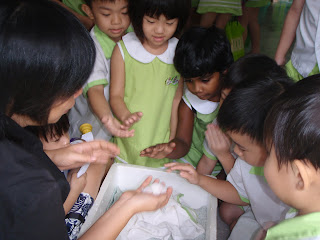
I am holding snowy with care!

Snowy is sleeping!

I want to touch!

Feeding time!

Taking her lunch!

so small!

finding the nipple!

This is my pet!

can i touch?

2 days old baby rabbit!

one week old sucking milk!

I can eat grass already!

I like the sun!

This is Snowy daddy!
In our kindergarten, any living things and non living things are our teaching material. As we practice holistic approach, we do not only confine our learning from the books, we also let children connect with the nature while building their character and value! How? You may ask, in QQ , we do keep pet, I have started with 2 rabbits in 2009 and later, it breed so many babies and we gave away some to QQ SP and QQ PS. The process of taking care of the rabbits from baby is so challenging and it really made our children laugh and cry! Our mummy rabbit Snow white, daughter Browny and now latest in the family snowy provide us with teaching opportunities and children with playmates. They invite social interaction and are a stimulus for learning and creativity.
What are the values we can cultivate from just having rabbit in our school?
1) Responsibility: Caring for the needs of an animal allows a child to make available something the animal cannot attain on its own. Children provide the pet with food, water, and clean housing and in the process, discover that they are needed and relied upon in a way they most likely have not experienced before. Responsibility is a natural outcome of the realization that, in this world, each person is necessary and uniquely important. Assuming responsibility, at its deepest level means children learn to be responsible for themselves, for their actions and hopefully for the global community.
3) Non-verbal communication: Brenda Bryant, a University of California-Davis Applied Behavioral Science Professor, explains that experiences with pets increase competence in children in ways that other learned tasks cannot. In addition to increased verbal skills, children naturally become more attuned to nonverbal communication as a result of interactions with their pet. This comes from their practice at “reading” their pet’s body language. But this skill is not restricted to their pet. These children also demonstrated the ability to draw the correct conclusions about emotions from human faces more accurately than those from homes without a pet.
4) Empathy: Since all animals need time to adjust to their new surroundings, we can explain the need to keep a quiet voice and to move slowly. This becomes a wonderful opportunity for us to explain about considering someone else’s feelings. By asking our children to consider how rightening this experience must be for their pet, we exemplify empathy and sensitivity. In addition, a relaxed animal is more likely to respond in a positive fashion to the child’s overtures. Robert Poresky, Associate Professor of Family Studies and Human Services at Kansas State University, found that three- and four-year olds with pets were better able to understand the feelings of other children than those without pets.
5) Patience and Tolerance: Children, who learn to care for an animal with kindness and patience, learn invaluable lessons in how to treat people as well. Pets don’t always do what a child wants. Although this creates frustration for the child, it opens an opportunity for parents to teach tolerance, respect, and patience.
6) Self-esteem: Simple caring tasks like cleaning a cage or water dish, feed the rabbit can help a child feel that they have achieved something. A job well done, especially if it is a bit of a challenge helps to build self-worth.
7) Life Cycles: Pets afford the opportunity for teacher to teach about sex, birth, grieving and death. Birth can be introduced as part of the total life cycle, the process of renewal. Witnessing animals breed, and then participating in the miraculous event of the nimal giving birth can be growing experiences for the child.


















